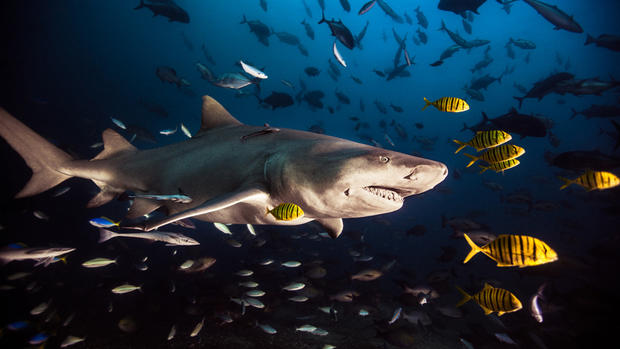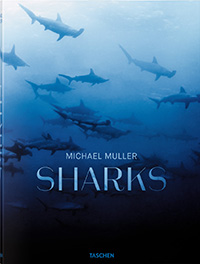Photographer gets up close and personal with great white sharks
For most of his career, photographer Michael Muller has gotten up close and personal with celebrities like "Iron Man" Robert Downey, Jr., and Olympian Michael Phelps. While lauded for these glossy portraits of the famous, for the past decade, the Los Angeles-based photographer has directed his lens at the pearly whites -- make that 15 rows of pearly whites -- of more unlikely subjects: sharks.
Muller set out to document the much-feared and misunderstood ocean dwellers with the same kind of attention to detail and dynamic flair that he brings to a Hollywood promotional shoot. To capture this unique view of a wide variety of sharks -- from hammerheads in the Bahamas to great whites off the coast of South Africa -- Muller headed underwater, free from a cage, with a patented seven-bulb, 1,200-watt plexi-encased strobe lighting rig developed with the help of NASA engineering.
The end result is a new 165-page book, "Sharks: Face-to-Face with the Ocean's Endangered Predator," full of strikingly beautiful, intimate shots of the animals. Muller even captures a milestone in the book -- the first known photograph of a great white shark breaching at night. Breaching refers to a hunting technique where the great white surprises and kills its prey, moving with such power that it jumps right out of the water.
Accompanying Muller's photos are essays by Philippe Cousteau, Jr., and marine biologist Alison Kock, who delve into the importance of conserving these creatures and their habitats.
Muller spoke with CBS News about his experience swimming with and documenting sharks, the need to advocate for better conservation, and what he's working on next. (This conversation has been condensed and edited).
Q: What first interested you about sharks?
A: I've always had a fascination with sharks. I was a surfer in northern California, I remember seeing "Jaws" when I was younger. There was always this fear-slash-fascination when it came to these animals. Then, 10 years ago, I wanted to go on a shark trip and for my birthday my wife sent me on a great white trip. The minute I saw that first great white, I was fascinated, I was drawn in.
Q: When you started photographing these sharks, did you always have a book in mind?
A: I didn't have a book in mind, so to speak. I went to the Galapagos for an IWC [Switzerland's International Watch Company] campaign. That was one trip that was when everything came together for me. I had this sort of, you know, I had this fulfillment that I hadn't gotten on my other jobs -- like movies, going on shoots, what have you. I was at the Galapagos and thought 'maybe I can sell these animals in a way that hasn't been seen before.'
People saw this book with sharks, coming at the light, swimming into the light, and thought 'holy s***, what's this?' It made them turn the pages, educated them.
Q: So, it really put these animals in a unique spotlight. Moving on literally to lights, tell me more about the NASA-engineered lighting rig you used. How exactly did you shoot these animals when you were underwater?
A: Well, I created these lights. They are the strongest strobe lights in the world and no one else in the world has them. What these lights did was they allowed me to bring a full-blown studio to the ocean. Basically, I was shooting the Speedo campaign with Michael phelps and had these underwater lights available. Think 400 strobes, the big HMI movie lights that James Cameron uses. A huge generator. Great equipment. So, there were two options -- you can't bring the shark to a studio, so you had to bring the studio to the sharks.
One guy outfitted the rig. He did it in Colorado. I sent him a ton of money, metal box with a hole cut out. Seriously, the most expensive metal box in the history of metal boxes! (Laughs.) The rig was created by a NASA engineer, it incorporated JPL (NASA's Jet Propulsion Laboratory).
Q: Given that this was providing a very different view of sharks than what people had seen before, what did you learn while working on this project? What surprised you the most about sharks?
A: Just that we aren't on their menu. There were all these preconceptions I had that were totally wrong. You know, the media totally demonized them. We're not on their menu. The first dive I did was in a cage. After that, I wasn't in cages, so, it was all about learning to get over those fears. To put away those misconceptions about these animals.
Q: Wow, what was that like to swim with sharks without the cage?
A: Once you start, you swim with 50 bull sharks swimming around you and you see that none of them are biting you. You know, you have all of your fingers intact. Learning about sharks and their behavior, you just see them as intelligent, emotional beings.
I always had a huge desire to swim with great whites out of that cage. I spent 10 years and hundreds of hours underwater. I swam with bull sharks, with great hammerheads, but I really wanted to swim with the great white. I got the ability and the confidence after meeting my mentor, Morne Hardenberg, who is just legendary. He's been swimming with the great whites for 25 years. He taught me, he's like the shark whisperer. Now, I'm able to swim with great whites with no cage.
Q: What is that experience like, to swim with a great white outside the cage? To connect with these animals that are demonized in so many ways? What is it like to be so close to them?
A: They are amazing animals. There are only 30 or 40 people that have the ability to swim with them outside a cage. Those are the people who have the balls to do it. I don't know what it is -- it's funny because no other animal swims toward them (great whites), everything swims away from them in the ocean.
Q: Is it scary? An adrenaline rush?
A: It's amazing. It's really a zen-type thing. People used to ask me for years 'why do you do this? Are you an adrenaline junkie?' And no, it's not adrenaline at all. It's just the opposite, actually. You are just totally in that moment, you have to really be in that moment to understand.
Q: Out of all the shots you took over this 10-year period, is there one that stands out? Do you have a favorite, or is there one that resonated in a particularly strong way with you?
A: I love them all. If there was one shot that took the most time and the most energy and that has the most meaning, it would be the great white breaching at nighttime.No one knew that they had done it, I was the only one to have photographed it. It took two trips to South Africa to capture that. We had to bring film crews, and these were expensive, full trips. Literally, on the last day of the second trip -- day five -- our last chance to capture it, we got it. It was very rewarding. So, I'd say that is probably the shot.
Trust me, I loved them all. It was hard to edit the book. I think there are about 30,000 images that we had to whittle down to 18,000 and then down to 12,000. It keeps getting smaller and smaller. We're now putting together a gallery exhibition and I have to select 30 images. It's tough.
Q: What do you want someone to say after they pick up this book, open it, flip through the pages, and see these images for the first time?
A: I want them to be like: 'Oh my God -- wow!' I want them to see sharks in a way they haven't been seen before. That is a big part of the book -- they learn that 100 million sharks are killed every year. They have to learn that conservation is important. I want them to learn something new, to see something they've never seen before.
Q: So, in a way, these photos can be a form of advocacy for conservation?
A: Yeah, exactly.
Q: What's next for you? More work with these sharks, or something new?
A: After 10 years, I think it's time to move on. I have a great white trip coming up in a couple months, but I'm starting another project with another animal.
Q: What's the animal?
A: Oh, I don't know if I can tell you.
Q: Oh, I see. Top secret?
A: Yes, it is! (Laughs.)
Q: Is it safe to say that, after years working in entertainment and athletics and fashion, did the sharks inspire you to move in a different direction, to take different kinds of photos?
A: This definitely inspired me to do more.
Q: Beyond the great whites, what other kinds of sharks stood out to you?
A: The tiger shark and the great hammerheads. Just because they are like the great whites, they're impressive, and powerful. These are the greatest predators, it's just really cool to see them in the wild.
Q: We talked a lot about what you want people to learn from seeing these images. What is that big takeaway?
A: I hope people can learn and change their perception about these animals. I want them to realize, along with climate change, what we are doing to our wildlife. I don't think people are going to see a lot of these animals in the wild, we are wiping them out. A lot needs to change.
"Sharks: Face-to-Face with the Ocean's Endangered Predator," is available for sale by Taschen.



